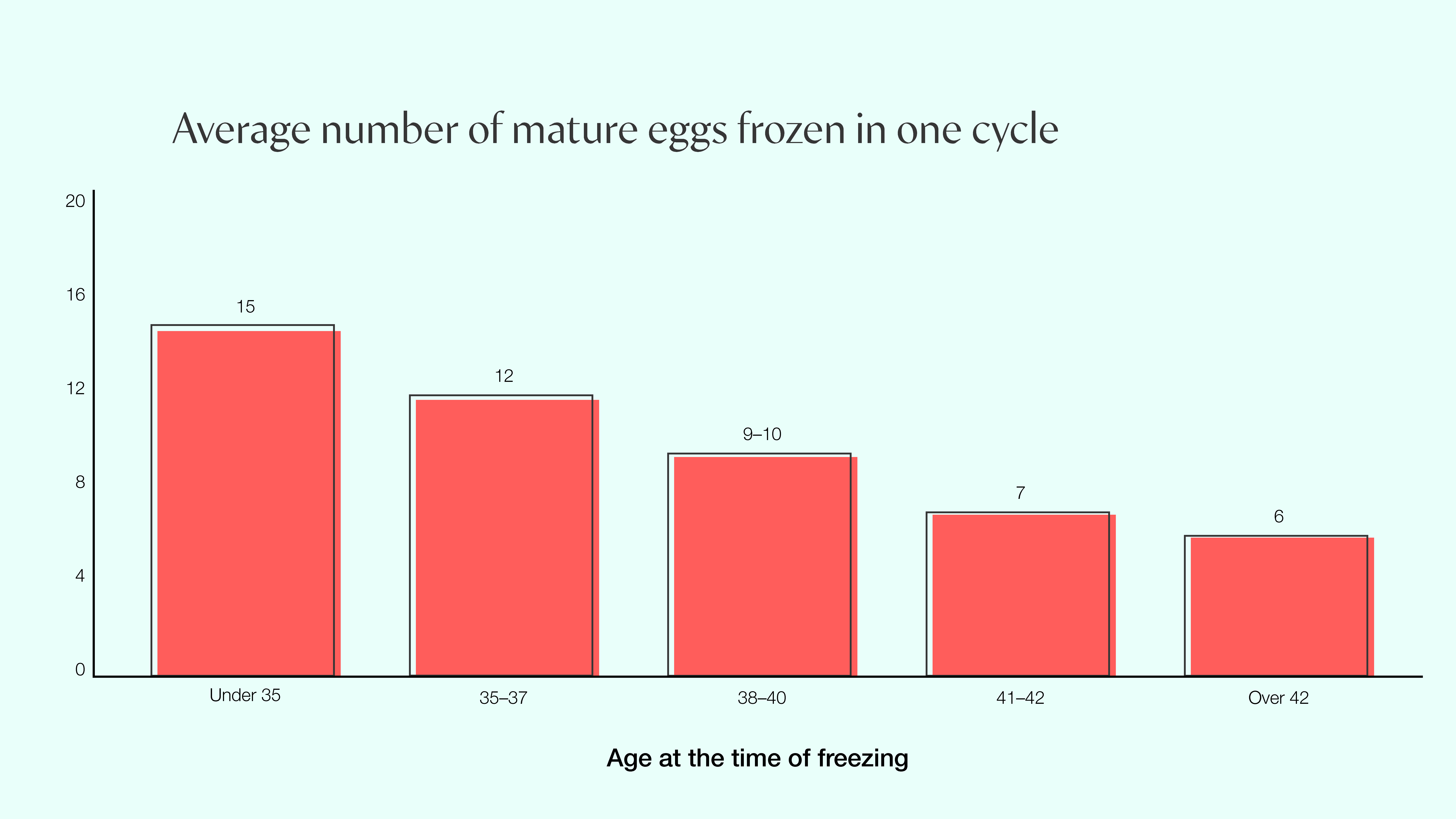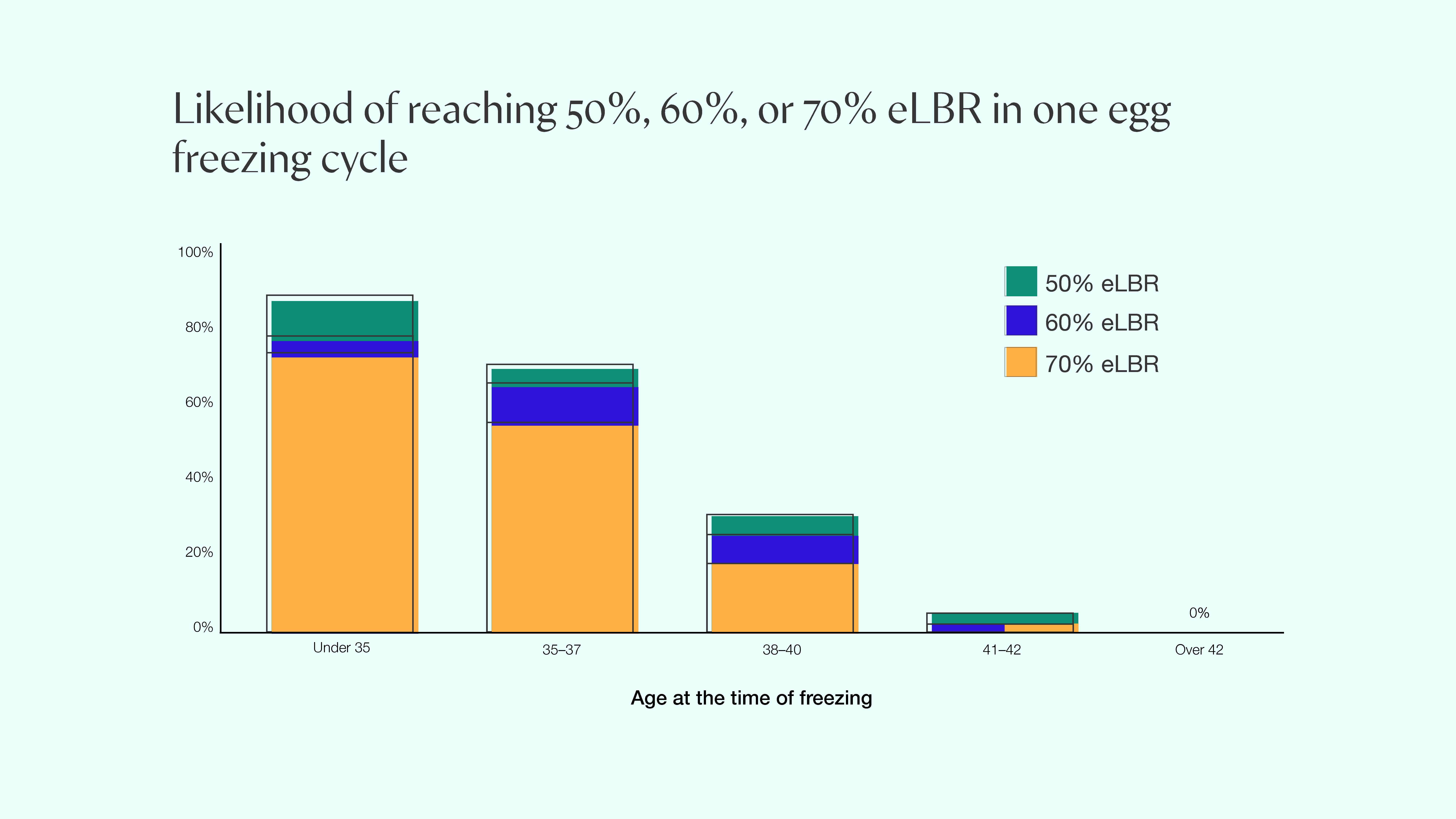
New Extend Fertility research analyzes estimated success rates after 1 or 2 cycles of egg freezing
One of our goals is not just to treat our own patients, but to use our expertise to improve the fertility field as a whole by providing evidence for best practices in egg freezing, IVF, and beyond. That’s why, in 2018, we founded the Center for Fertility Research and Education, with a mission to close the knowledge gap about fertility and fertility preservation.
While oocyte cryopreservation technology has been in use regularly since 2012, data about egg freezing success rates is still limited, and much of what we currently know relies on extrapolation from IVF cycle success rates. In 2018, the American Society for Reproductive Medicine (ASRM) called for more research regarding pregnancy chances after egg freezing, in order to facilitate better provider counseling and more informed patient decision-making.
Our recent research addresses this issue, providing the fertility field with more data to predict success rates after one or two egg freezing cycles. The paper, titled “Likelihood of achieving a 50%, 60%, or 70% estimated live birth rate threshold with 1 or 2 cycles of planned oocyte cryopreservation,” was published in the Journal of Assisted Reproduction and Genetics in May.
This paper offers patients and providers alike a way to weigh the costs and benefits of egg freezing based on each individual patient’s age and goals.
In 2018, the American Society for Reproductive Medicine called for more research regarding pregnancy chances after egg freezing, in order to facilitate better provider counseling and more informed patient decision-making. Our recent research addresses this issue.
Background information
Estimated live birth rate
Estimated live birth rate (eLBR) can be defined as the chance of having a baby from frozen eggs when used in IVF later in life. We’ve found that many patients interested in egg freezing want to ensure that the procedure gives them at least a 50% chance of a baby later on. In this study, we looked at the likelihood of reaching a 50%, 60%, or 70% eLBR.
The impact of age on success rates
Age impacts egg freezing success rates in two ways. First of all, women have a lower egg supply as they get older; therefore, younger women are able to freeze more eggs per cycle than older women.
Secondly, as women age, a higher proportion of their eggs will be genetically abnormal (this issue is known as “egg quality”). What that means is that each egg will have a lower chance of becoming a healthy baby. A 2016 study of 1,171 IVF cycles using frozen eggs found that, for women under 30, each egg retrieved had a 8.67% chance of resulting in a child; for women over 40, that chance dropped to less than 3% per egg. So, to achieve a 50% estimated live birth rate, a woman over 40 will need to freeze significantly more eggs than a woman under 30.
Therefore, age presents a double disadvantage when it comes to fertility: as women get older, they need to freeze more eggs for the same chance of live birth, but also retrieve fewer eggs per cycle. This is why multiple cycles are more common for older women.
How many eggs does a patient need to freeze?
We extrapolated the aforementioned 2016 study of IVF cycles with frozen eggs, along with a model created in 2017 based on 520 IVF cycles in healthy women. The results:
| Patient age | Number of mature eggs you must freeze to attain a 50% eLBR | Number of mature eggs you must freeze to attain a 60% eLBR | Number of mature eggs you must freeze to attain a 70% eLBR | |
| Under 35 | 6 eggs | 8 eggs | 9 eggs | |
| 35–37 | 7 eggs | 8 eggs | 10 eggs | |
| 38–40 | 11 eggs | 13 eggs | 16 eggs | |
| 41–42 | 20 eggs | 24 eggs | 28 eggs | |
| Over 42 | 50 eggs | 70 eggs | 80 eggs |
Our analysis
Other studies have given us the number of eggs necessary to reach a 50%, 60%, or 70% estimated live birth rate. Our study explored how likely it was to freeze that number of eggs in a single cycle, as well as how successful patients were after a second cycle.
This study was a retrospective analysis of 1,799 egg freezing cycles among 1,241 healthy patients. Patients’ average age was 35.
Number of eggs frozen per cycle
Unsurprisingly, we found that the number of mature eggs a patient was able to freeze per cycle declined with age. Our analysis demonstrated that a patient under age 35 freezes 15 eggs per cycle, on average, while a patient over age 40 will freeze half that, or less.

Success rates after one cycle
Two-thirds (66%) of patients had at least a 50% eLBR after a single egg freezing cycle. (Just over half of our patients actually achieved a 70% eLBR after one egg freezing cycle.)
The likelihood of freezing enough eggs in one cycle for a high chance of live birth later was, once again, strongly correlated with patients’ ages. While 88% of patients under 35 reached the 50% threshold in just one cycle, that dropped to 32% among patients ages 38–40.
| Patient age | Likelihood of attaining a 50% eLBR | Likelihood of attaining a 60% eLBR | Likelihood of attaining a 70% eLBR |
|---|---|---|---|
| Under 35 | 88% | 78% | 74% |
| 35–37 | 72% | 66% | 55% |
| 38–40 | 32% | 26% | 18% |
| 41–42 | 4% | 2% | 2% |
| Over 42 | 0% | 0% | 0% |

After a second cycle
We also analyzed the subsequent cycles of 245 patients, finding that 69% of those patients were able to attain at least a 50% eLBR after their second cycle. As with the previous cycle, results were tied closely with age.
| Patient age | Likelihood of attaining a 50% eLBR | Likelihood of attaining a 60% eLBR | Likelihood of attaining a 70% eLBR |
|---|---|---|---|
| Under 35 | 95% | 89% | 85% |
| 35–37 | 87% | 83% | 72% |
| 38–40 | 56% | 47% | 32% |
| 41–42 | 16% | 14% | 12% |
| Over 42 | 0% | 0% | 0% |
The bottom line
A single cycle of egg freezing offers most women an opportunity to increase their chance of having a genetic child (or children), should they experience infertility later in life.
Patients freezing their eggs before age 37 can expect a high likelihood of achieving their egg freezing goals in just one cycle. In contrast, patients freezing their eggs after age 38 are more likely to need two or more cycles to reach their goals.
A single cycle of egg freezing offers most women an opportunity to increase their chance of having a genetic child (or children), should they experience infertility later in life.
How will this study be used to improve care?
One of the biggest concerns among patients considering egg freezing is the uncertainty of the procedure. How many eggs can I realistically expect to freeze in a cycle? Will I be able to freeze enough eggs to really make a difference in my chance of pregnancy later on? Will I need multiple cycles? How much will it really cost to reach my egg freezing goals?
All of the above are questions we hear from egg freezing patients that can be answered in part by the data in this study. This analysis provides an evidence-based way to counsel potential egg freezing patients about their chance of success, clarify how many cycles they’re likely to need, and help them plan for the financial undertaking of egg freezing.
It also provides a way for patients to consider their own version of egg freezing “success.” Is a 50% estimated live birth rate acceptable, as it might be for those who aren’t sure if they want children, but want to freeze their eggs “just in case”? Or is a 70% eLBR worth the potential need for a second cycle—as it may be for women who are certain they want a child, but are waiting for a partner or to finish school or professional training?
Finally, these findings underscore the impact of advancing age on egg freezing success rates. Older women are more likely to need multiple cycles, with higher doses of stimulation, to achieve similar results as younger women (all resulting in much higher associated costs). Conversely, most younger women can achieve a high likelihood of success with just one or two cycles. This is an essential piece of data for women debating freezing eggs now or waiting until age 35, 36, or later.




